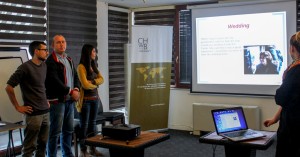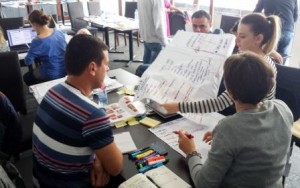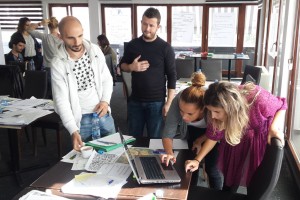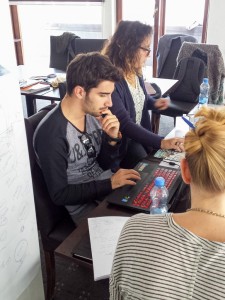Oct 21 - 2015
 On Friday evening, participants of the 25th Regional Restoration Camp gathered in Prizren to mark a successful end to the Camp and to celebrate their achievements. For two weeks, 20 participants from 7 countries came together to learn the fundamentals of heritage interpretation and come up with creative ways of interpreting Prizren Castle for local families, school children and national and international tourists. This Camp is the first of its kind to focus entirely on the interpretation of heritage.
On Friday evening, participants of the 25th Regional Restoration Camp gathered in Prizren to mark a successful end to the Camp and to celebrate their achievements. For two weeks, 20 participants from 7 countries came together to learn the fundamentals of heritage interpretation and come up with creative ways of interpreting Prizren Castle for local families, school children and national and international tourists. This Camp is the first of its kind to focus entirely on the interpretation of heritage.
Interpretation is a fast-growing specialization within the museum and heritage fields that helps museum curators and site managers better communicate the value of heritage to their visitors. It is about connecting people and place, bringing the past into the present, creating interactive learning experiences and opening up to critical reflection. Interpretation uses such techniques as storytelling, guides, panels, creative installations and electronic media to help audiences discover the values of heritage.
Through the Camp, participants went through a very intensified process of interpretation, moving from theory to practice, and focusing on different interpretation methods to reveal the exciting values of Prizren Castle to visitors. The four working groups focused on: 1) video/oral history, 2) object interpretation, 3) panels and walking trails, and 4) a website and digital interpretation.
Video/oral history
 The group that focused on videography and oral histories spent a lot of time in the castle and in the streets of Prizren. Assisted by members of the Dokufestteam, they recorded interviews with many people, young and old, local and foreign, about their impressions of and experience with the castle in Prizren. They used this the power of audiovisual media to express the personal connections that people have with their heritage—from tourists who enjoy exploring the ruins to an old woman who remembers attending a wedding in the castle. These oral histories, coming from people with different ethnic, religious and social backgrounds, also highlight Prizren’s rich diversity and many layers.
The group that focused on videography and oral histories spent a lot of time in the castle and in the streets of Prizren. Assisted by members of the Dokufestteam, they recorded interviews with many people, young and old, local and foreign, about their impressions of and experience with the castle in Prizren. They used this the power of audiovisual media to express the personal connections that people have with their heritage—from tourists who enjoy exploring the ruins to an old woman who remembers attending a wedding in the castle. These oral histories, coming from people with different ethnic, religious and social backgrounds, also highlight Prizren’s rich diversity and many layers.
Object interpretation
 Exciting archaeological discoveries are uncovering many hidden stories about the site, helping us to understand its historical significance and how the castle was built and contributed to domestic and military life in Prizren. The object interpretation group showed how each of these objects can tell the story of Prizren. They used a trail of objects as a means of linking two local museums with the castle. They also brought heritage into the present by showing the connections between many of the original objects found in the castle and the rich craftsmanship that continues today in Prizren.
Exciting archaeological discoveries are uncovering many hidden stories about the site, helping us to understand its historical significance and how the castle was built and contributed to domestic and military life in Prizren. The object interpretation group showed how each of these objects can tell the story of Prizren. They used a trail of objects as a means of linking two local museums with the castle. They also brought heritage into the present by showing the connections between many of the original objects found in the castle and the rich craftsmanship that continues today in Prizren.
Panels & walking trails
 The panels and walking trails group developed three distinct trails to and through the castle, each one with different objectives and for different types of visitors. The most direct route to the castle through the historic center features the ‘Journey of the Stone,’ which tells children (of all ages!) about how the stones of the castle are spread throughout the city—an opportunity to teach about the layers of history and uses of heritage in Prizren. The Marash Trail is a longer walking and biking route, which takes visitors on a beautiful nature trail up to the rear entrance of the castle. Finally, a trail within the castle called ‘Revealing the layers of life’ reaches all of the highlights within the castle walls, revealing surprising discoveries about the lives of people that used the castle over the centuries.
The panels and walking trails group developed three distinct trails to and through the castle, each one with different objectives and for different types of visitors. The most direct route to the castle through the historic center features the ‘Journey of the Stone,’ which tells children (of all ages!) about how the stones of the castle are spread throughout the city—an opportunity to teach about the layers of history and uses of heritage in Prizren. The Marash Trail is a longer walking and biking route, which takes visitors on a beautiful nature trail up to the rear entrance of the castle. Finally, a trail within the castle called ‘Revealing the layers of life’ reaches all of the highlights within the castle walls, revealing surprising discoveries about the lives of people that used the castle over the centuries.
Website & digital interpretation
 The group that focused on digital interpretation managed to build a brand new website for Prizren Castle, which you can visit at prizrencastle.org. This website provides an easy and accessible overview of the castle, as well as linking to the interpretation ideas produced by the other groups. It highlights the three key topics of this camp: location, life, and layers.
The group that focused on digital interpretation managed to build a brand new website for Prizren Castle, which you can visit at prizrencastle.org. This website provides an easy and accessible overview of the castle, as well as linking to the interpretation ideas produced by the other groups. It highlights the three key topics of this camp: location, life, and layers.
The interpretation camp in Prizren wraps up the Regional Restoration Camps for 2015. Be sure to check our website and the Regional Restoration Camps’ Facebook page in early 2016 for the announcement of next year’s camps.